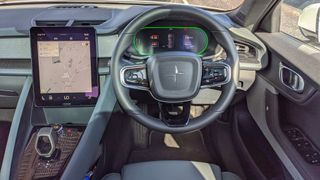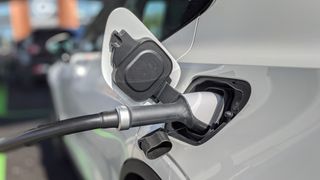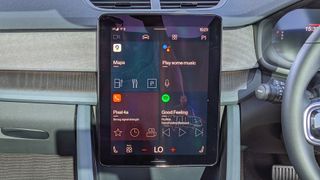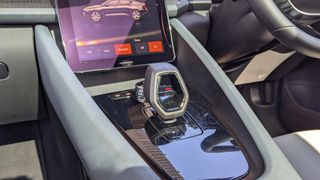Polestar 2 review: all-electric performance, powered by Google
A heady mix of performance and technology

Polestar may not be a household name just yet, but the fledgling electric car company has big ambitions, and with its second car (its first fully-electric), the Polestar 2, it's taking the fight directly to Tesla.
The 5-door all-electric fastback has enough space for four adults, boasts impressive performance, and comes with Google's in-car entertainment system, which bakes the Google voice assistant, Google Maps and Google Play Store directly into the interface.
Polestar 2 prices start at $59,900 / £39,900, but add the long-range dual-motor (dual-motor is standard in the US), non-standard paint and the Pilot, Plus and Performance packs to the car we drove and you're looking at $67,400 / £58,800 for the mode; we drove.
That's cheaper than a Tesla Model S, but pricier than a Tesla Model 3 (in the US that is – the Model 3 price is similar in the UK).
- Ford Mustang Mach-E: ignore the name, this is a solid electric car
- Audi e-tron: driving the first all-electric Audi
- Mercedes EQS: fully electric, with a massive 56-inch Hyperscreen
Polestar 2 design

Polestar 2 Long Range
Power: 402bhp
Battery: 78kWh
Top Speed: 127 mph
0-62mph: 4.7 seconds
Range: up to 300 miles
Price: £58,800
The Polestar 2's powerful stance gives it an almost muscle car-esque look, taking cues from its sibling, the Polestar 1. The big wheels carve high into the frame for a sportier aesthetic, while there are also design elements taken from Polestar's parent company, Volvo, such as the shape of the light blocks.
It's an attractive offering, and while it doesn’t have the same stage presence as a supercar, the Polestar 2 is still able to turn heads thanks to its design and, likely, its badge, which still leaves some onlookers wondering who exactly makes it.
There are a few nice, smaller touches too, including eye-catching bezel-less wing mirrors, and a projector that subtly shines a small Polestar logo onto the panoramic glass roof at night.
Get daily insight, inspiration and deals in your inbox
Get the hottest deals available in your inbox plus news, reviews, opinion, analysis and more from the TechRadar team.
Our Polestar 2 came equipped with the additional Performance Pack ($5,000 / £5,000), which sees gold seatbelts, 20-inch wheels with gold valve-caps, gold front calipers, and a black gloss roof bolted onto the car.
Now, we're not adverse to a bit of bling, and we found the gold highlights were a pleasing visual addition – although they may not be to everyone's taste, and the asking price for the pack seems rather high.
Climb inside this electric car and you'll find a simplified cabin, with minimal buttons and an open, airy feel. It doesn't feel quite as premium as similar-spec Audis and BMWs, but it's comfortable, with good leg and headroom, as well as accommodating, heated seats.
In terms of storage, there are a couple of small pockets either side of the transmission tunnel – the perfect size for keys and a phone, for both the driver and front passenger.
You also get a storage area at the base of the center console that's large enough for a wallet, phone and other small items, plus one drinks holder. There is a second drinks holder in the storage area under the armrest, but the driver may find that a bottle placed here impedes their elbow room.
The Polestar 2 has enough room for two adults in the back, allowing them to comfortably enjoy long journeys with heated seat options here too, while the boot provides ample luggage space.
As this is an electric car, there's also some room at the other end of the Polestar 2, with a front trunk under the hood providing enough space for one or two overnight bags.








Polestar 2 drive, range and charging
The Polestar 2 provides an exhilarating driving experience, matching the likes of the Tesla Model S when it comes to acceleration and handling.
Its low, evenly distributed center of gravity provides great stability, allowing you to vigorously attack corners and come out smoothly on the other side. We did find the ride was a little stiff though, so for those looking for a long-distance cruiser the ride comfort may be slightly impacted.
Dip into the settings on the central touchscreen and you'll find a few options that you can adjust to customize your driving experience.
You can change the steering wheel responsiveness, with the choice of light, standard and firm, opt to enable OnePedal drive (and switch between low and standard settings) which sees the Polestar 2 brake when you lift off the accelerator, meaning no switching between pedals, and enable or disable 'creep' – when enabled the car will continue to roll forward after you come to a stop and take your foot off the brake.

The options here aren't exactly groundbreaking, but it's nice to have the ability to easily customize the drive to your preferred style.
As mentioned, we drove the long-range, dual-motor model, which gives you a 78kW battery, 408hp and a supremely swift 0-60mph time of 4.7 seconds, although if you opt for the more affordable single-motor model that time drops to 7.4 seconds, which still isn't slow.
The long-range dual-motor Polestar 2 has a claimed range of 450-480km (around 280-300 miles) WLTP (the lab test standard for EV range), however we found with our mix of driving conditions (and some seasonably cold weather) we got around 200 miles per charge.
That's still a decent amount of range, and will allow for plenty of return journeys without the need for a top-up, but longer distances will require a little bit of planning.
If you want more range, your best option is to go for the long-range, single-motor Polestar 2, which has a claimed range of 515-540km (around 320-335 miles) WLTP.
We took the Polestar 2 to a fast-charging, 350kW charging station where we were able to replenish 60% of charge in 44 minutes, which equated to over 100 miles of range.

Polestar 2 specs and tech
In a similar vein to Tesla's cars, the interior of the Polestar 2 is minimalist, with the main attraction being the large, portrait-orientated touchscreen which dominates the center console.
The Polestar is the world's first car with Google's Android Automotive OS built in, offering a familiar smartphone-esque look and feel. The touch interface is easy to operate, and with Google Maps baked into the system, navigation is excellent.
Sign in to your Google account on the system, and your Google search history and saved locations will be pulled through, making it even easier to find the location you want.
You also get the Google Assistant built in, allowing you to say "okay Google" and then ask whatever question is on your mind – from directions to your next destination, to turning up the heating, or anything the world of Google search can answer.

We found the voice recognition worked very well, with the Polestar 2 able to accurately hear what we were saying, even when traveling at high speeds.
Another benefit of having the Android Automotive OS at your fingertips is that it offers access to the Google Play Store, the home for all Android apps, allowing you to download key applications.
Be warned though: the current selection of available apps is extremely limited, although we hope more will be added in the near future. Those that are available (in the UK at least) include Spotify, Tidal, YouTube Music, plus a variety of radio players and more.
We used the Spotify app extensively, and having the ability to sign in to your account and have instant access to all your playlists, albums and history is hugely useful.
You can also connect your smartphone via Bluetooth to the Polestar 2, giving you hands-free access to calls and messages, and the ability to stream audio directly from your handset if your app of choice isn't available in the Play Store.




There is another display in the Polestar 2, and it functions as the instrument cluster behind the steering wheel. There's a small amount of customization afforded here, with three different views to choose from.
The most detailed of these is the map view, which shows you your speed on the left corner and charge on the right, but with most of the display in between taken up by Google Maps. This makes navigation easier, as you don't have to look over at the main display, instead just flicking your eyes down to this cluster screen.
While most of the controls for the Polestar 2, including climate controls, are accessed via the infotainment display, there are a handful of physical switches present too. There's a handy physical circular dial just behind the drive shift for adjusting volume, with a button in the center of it which acts as an audio play/pause control.
You'll find a wireless charging pad and two USB-C ports at the base of the touchscreen, allowing you to charge your smartphone and other devices, while rear-seat passengers also get access to a couple more USB-C ports, along with heated seat buttons.

The Polestar 2 features an array of driving aids, including auto lights, adaptive cruise, lane-keeping assistance, driver alert and road-sign information, all of which make driving safer and less taxing.
It also offers a function called Pilot Assist, which uses the adaptive cruise and lane-keeping aids to steer and drive the car for you. It won't change lanes for you, or leave one road to go onto another, but if you're going to be driving the same road for a long time, the Polestar 2 can pretty much do it by itself.
We've seen similar implementations on a number of other vehicles, but something we found a little unnerving here was the car's preference of hugging one side of the lane rather tightly. At times it was a little too close for comfort, and we found we were frequently having to re-center the car. It wasn't a big issue, but we have used better systems elsewhere.
You also get 360-degree cameras, which offer a high-quality view of the surroundings of the car, allowing you to maneuver easily in tight spaces.
Verdict
The Polestar 2 is a striking electric car, offering a heady mix of performance and technology that will appeal to those already embedded in the Google ecosystem.
Putting a mobile operating system into the car makes a lot of sense, and the Android Automotive interface is extremely easy to use; and with Google Maps at your fingertips, it provides one of the best in-car navigation experiences you can get.
The interface is a little more limited compared to Tesla's feature-packed offering, but for those looking for a cleaner, simpler system in a car that can still thrill, the Polestar 2 is worth considering.

- John McCann is getting behind the wheel to give you an alternative look at the world of fully electric and plug-in hybrid electric cars – and the tech inside them – that are available today. From the super-fast to the tech-packed, he'll take you through a range of makes, models, power and price tags in his regular TR Drives column.

John joined TechRadar over a decade ago as Staff Writer for Phones, and over the years has built up a vast knowledge of the tech industry. He's interviewed CEOs from some of the world's biggest tech firms, visited their HQs and has appeared on live TV and radio, including Sky News, BBC News, BBC World News, Al Jazeera, LBC and BBC Radio 4. Originally specializing in phones, tablets and wearables, John is now TechRadar's resident automotive expert, reviewing the latest and greatest EVs and PHEVs on the market. John also looks after the day-to-day running of the site.
Most Popular

